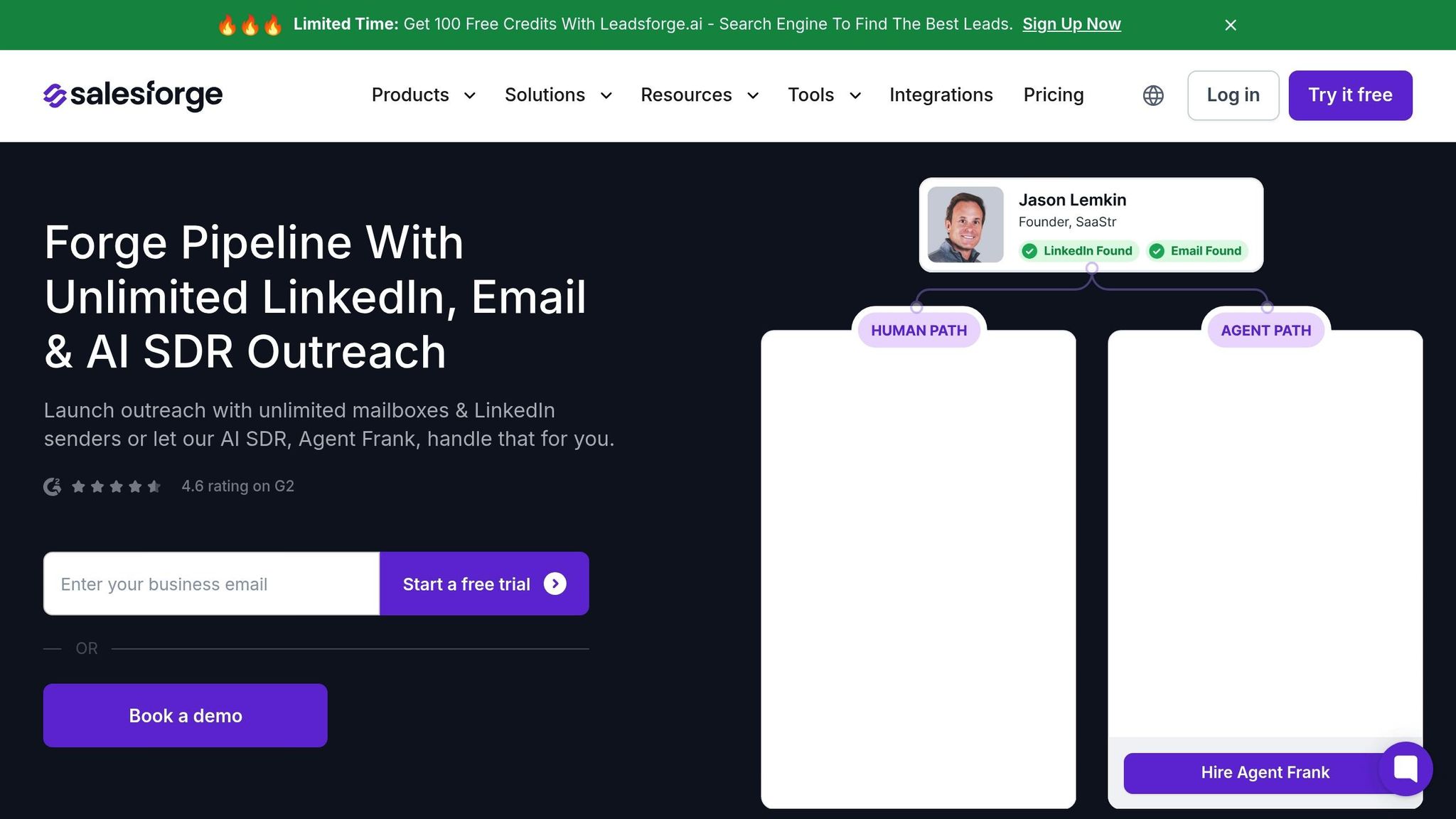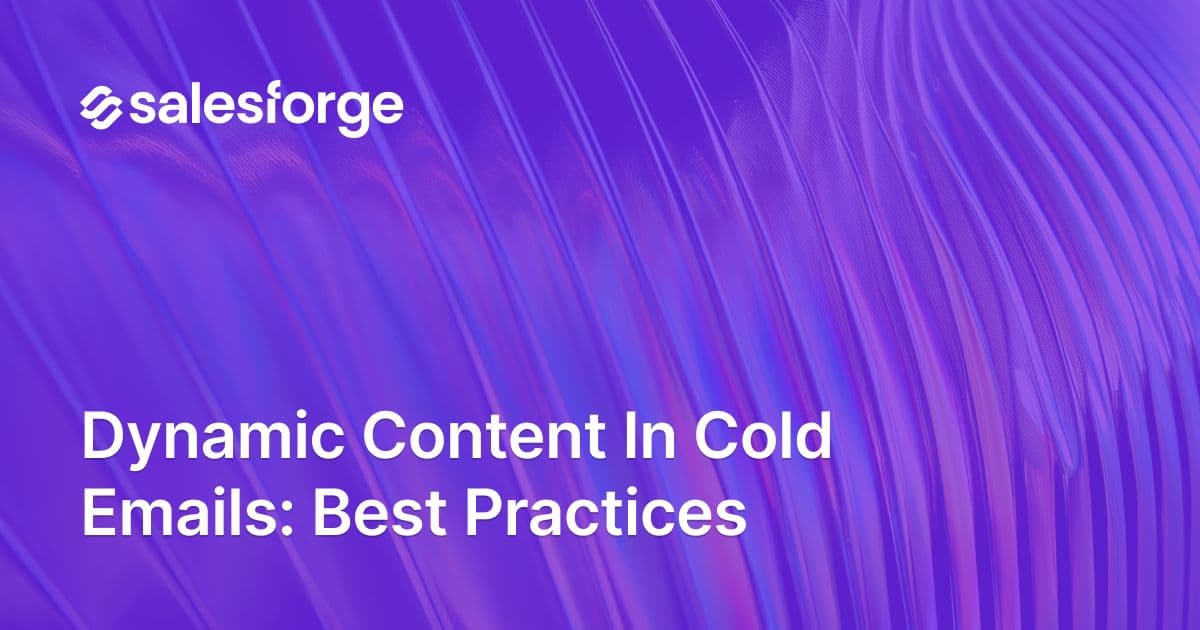Dynamic Content in Cold Emails: Best Practices
Dynamic content in cold emails uses personalized details to make your messages feel tailored and relevant. By incorporating recipient-specific information like job titles, company names, or recent achievements, you can improve open rates by 26% and click-through rates by 14%.
Here’s how to make it work:
- Use accurate data: Ensure your CRM has up-to-date details like names, roles, and company activities. Tools like Clay can enrich and validate your data.
- Design flexible templates: Use placeholders (e.g.,
{{first_name}},{{company}}) and modular sections to adjust emails based on available information. - Focus on deliverability: Validate email addresses, warm up your domain, and authenticate with SPF, DKIM, and DMARC to avoid spam folders.
- Personalize wisely: Mention relevant details in subject lines and openers, and tailor value propositions to each recipient's role or industry.
Avoid over-personalizing (e.g., using overly private details) or relying on outdated information, as these can harm your credibility. Tools like Salesforge simplify the process with AI-driven personalization and built-in email warm-up services. By combining strong data, thoughtful templates, and robust deliverability practices, you can create cold emails that connect and drive results.
Checklist for Setting Up Dynamic Content in Cold Emails
Creating dynamic content for cold emails involves a careful process to ensure your personalization efforts actually resonate with recipients. It all starts with high-quality data, followed by adaptable templates and strong email deliverability practices. Here's a clear guide to help you get everything in place.
Collect Quality Data for Personalization
The success of dynamic content hinges on the accuracy of your data. Even minor errors can throw off your entire campaign, so accurate and up-to-date information is key.
Start by connecting your CRM, like Salesforce or HubSpot, to your email platform. These tools hold valuable details such as names, job titles, company information, and interaction history. Additionally, incorporate website behavioral analytics to track which pages prospects visit or what content they download - these actions signal genuine interest you can leverage in your emails.
For an extra edge, consider using intent data platforms. These tools reveal when prospects are actively researching solutions in your industry. For example, if someone from TechCorp is reading about marketing automation tools, that's the perfect moment to reach out with your marketing solutions.
To protect your sender reputation, keep your data clean. Even a small bounce rate, like 1%, can harm your email performance. Automate regular data checks to flag outdated email addresses, incomplete records, or missing fields like company names or job titles.
You can also use lead enrichment tools like Clay to fill in the gaps. These platforms gather insights like recent job changes, company updates, or industry challenges, giving you more context to craft targeted messages.
Once your data is solid, move on to designing email templates that reflect this level of personalization.
Create Flexible Email Templates
With high-quality data in hand, the next step is to craft templates that feel personal yet adaptable to different recipients. Use dynamic placeholders for key details and make sure the tone stays conversational, even when certain data points are missing.
Structure your templates with modular sections that can be swapped in or out depending on the data you have. Start with basics like {{first_name}}, {{company}}, and {{job_title}}, and expand to include variables like {{industry}}, {{pain_point}}, or {{recent_achievement}}.
Here’s an example of a dynamic email template: "Hi {{first_name}}, I noticed your work at {{company}} in the {{industry}} sector. Many {{industry}} leaders face {{pain_point}}, and we've helped companies like {{reference_company}} solve this with {{solution}}. Would you be open to a quick call next week?"
If you’re missing a recipient’s first name, the template should default to something like: "Hi there, I noticed your work at {{company}}." This ensures your email still reads naturally, even with incomplete data.
Always test your templates with different data combinations to confirm they work seamlessly. Whether you’re addressing a fully detailed profile or a more basic one, your emails should always sound smooth and engaging.
Improve Deliverability and Validation
No matter how personalized your email is, it won’t matter if it ends up in a spam folder. Ensuring your emails actually reach recipients is just as important as the content itself.
Start by validating email addresses before adding them to your campaigns. Invalid addresses can damage your sender reputation and hurt overall deliverability.
Use email warm-up tools like Warmforge to build credibility with email providers. These tools gradually increase your sending volume while maintaining positive engagement signals, helping you avoid spam filters - especially important when scaling campaigns.
Keep an eye on your sender reputation by tracking metrics like delivery rates, open rates, and spam complaints. A dip in any of these areas can signal a problem that needs immediate attention.
Finally, make sure your domain is properly authenticated with SPF, DKIM, and DMARC records. These technical settings confirm you’re authorized to send emails from your domain, boosting trust with email providers and improving inbox placement.
Best Practices for Using Dynamic Content
Once your templates and data are set up, it's time to use dynamic content to craft emails that truly resonate. The difference between a meaningful personalized email and a run-of-the-mill automated one lies in thoughtful strategies that make each message feel relevant and timely.
Personalize Subject Lines and Openers
Your subject line sets the tone for your email, and when personalized effectively, it can increase open rates by up to 26%. But personalization goes beyond just inserting a name - it’s about adding context that feels tailored.
Skip overused tags like "%%first_name%%, quick question" and instead weave in details that show genuine effort. For instance, "Hi John, saw your recent expansion in Dallas - congrats!" combines a name with a location for a more engaging touch.
For openers, use recent actions or interactions as cues. If someone downloaded your whitepaper on sales automation, you could start with: "I noticed you downloaded our whitepaper on sales automation - here’s how our platform can help you apply those strategies." This kind of opener feels attentive and naturally leads into your message.
Avoid bland greetings and instead mention specific business details. Tools like Salesforge's Agent Frank can help you craft context-rich openers by mimicking the habits of top-performing salespeople.
Timing also matters. If you’re reaching out to a CFO during budget season, reference challenges like quarterly planning. For operations managers, focus on solutions that address efficiency during peak times. Once you’ve captured attention with a compelling opener, shift toward presenting a value proposition that speaks directly to their needs.
Customize Value Propositions
Your value proposition should feel like it was written specifically for the recipient. Generic benefits won’t cut it - tailored solutions are what drive conversions.
Segment your audience by role, industry, or business challenges, and use dynamic blocks to speak directly to their priorities. For example, highlight time-saving features for operations managers or cost-cutting solutions for CFOs. Adding industry benchmarks can bolster your credibility. Instead of saying, "Our tool improves productivity", try, "Companies in your sector have seen a 30% productivity boost using our solution."
A great example comes from UniteSync, which achieved an 85.26% positive reply rate and a $2.86 Customer Acquisition Cost by targeting music creators with unclaimed royalties.
Carlos Palop Moliner, CEO of UniteSync, shared that their personalized messaging centered around solving a specific pain point: identifying and claiming uncollected royalties.
Dynamic content platforms like Salesforge can automate the process by adjusting your value proposition to match each recipient’s role, industry, or company size. This eliminates the need for manual tweaks while keeping your messaging relevant.
Include Relevant Social Proof
To reinforce your value proposition, incorporate social proof that aligns with the recipient’s context. Generic testimonials often fall flat, but case studies and data tailored to their industry or business challenges can make a big impact.
Match your examples to the recipient’s industry, company size, or specific pain points. For instance, when reaching out to a healthcare company, you might share: "MedTech Solutions reduced patient wait times by 40% using our scheduling platform." This is far more compelling than a vague statement about improving efficiency.
Whenever possible, include concrete numbers, timelines, and recognizable brands. For example, "TechCorp reduced customer churn by 23% within six months" is much more persuasive than a general claim about retention improvements.
Dynamic content tools can help here too, automatically inserting the most relevant social proof based on attributes like company size or industry. For a mid-sized business, you might showcase case studies from similar organizations, while enterprise prospects might see examples featuring Fortune 500 clients.
To make your social proof even more memorable, pair it with visuals like infographics, client logos, or charts that align with the recipient’s industry. The goal is to make your social proof feel like a glimpse of what’s possible for their specific situation - not just evidence that your product works in general.
Tools for Dynamic Content Personalization
When it comes to dynamic content, selecting the right tool can make all the difference. Not all platforms are created equal - features and functionality can vary widely. The key is to find a solution that fits your outreach goals and technical needs.
Salesforge: AI-Driven Personalization Made Easy

Salesforge leverages AI to craft emails that are not only highly personalized but also contextually relevant. Its standout feature, Agent Frank, automates the entire outreach process - from generating leads to booking meetings. Agent Frank can handle up to 2,000 contacts each month for just $0.25 per contact. This means you can achieve a high level of personalization without spending hours on manual tasks.
Another key feature is Warmforge, an unlimited email warm-up service that ensures your emails land in inboxes, not spam folders. It also validates email addresses to improve deliverability. Salesforge supports personalization in 20 languages and simplifies managing multiple mailboxes with Primebox, making it a great choice for large-scale campaigns.
The Growth Plan, priced at $80 per month (billed annually), includes 10,000 active contacts, 50,000 monthly emails, and 1,000 personalization credits. This eliminates the need for additional tools for email warm-up, validation, or personalization, saving time and money while delivering a seamless experience.
How Salesforge Compares to Other Platforms
Many other platforms rely on basic template-based personalization and often require third-party tools for email warm-up or validation. Salesforge, on the other hand, offers a fully integrated solution. Its AI-powered personalization, automated outreach through Agent Frank, built-in email warm-up, and validation work together seamlessly. This all-in-one approach streamlines workflows and ensures your personalized emails reach their targets effectively and efficiently.
Common Mistakes to Avoid with Dynamic Content
Dynamic content can be a powerful tool, but when misused, it can backfire and harm both your outreach efforts and your brand’s reputation. By understanding and addressing common pitfalls, you can create campaigns that resonate with your audience while maintaining trust and technical reliability.
Over-Personalization Risks
Going overboard with personalization can feel invasive and erode trust. Stick to referencing business-related details like company names, professional roles, or recent achievements that are publicly available. For instance, congratulating someone on a promotion they shared on LinkedIn is fine, but mentioning personal details, like their vacation photos, crosses a boundary and could lead to unsubscribes or spam complaints.
The key is to use personalization to enhance relevance, not to flaunt your ability to collect data. Every dynamic element should serve a clear purpose, making your message more meaningful and useful to the recipient. Before sending, test your emails for tone and appropriateness to ensure they come across as professional rather than intrusive. Keeping personalization strictly business-focused helps build trust and encourages engagement.
Technical Compatibility Issues
Dynamic content doesn’t always behave as expected across different email clients and devices. For example, Gmail might display your dynamic images perfectly, while Outlook strips them out, leaving your email with broken formatting or missing elements. These inconsistencies can make your message look unprofessional and even trigger spam filters.
When email clients struggle to process dynamic elements, your message may be flagged as suspicious or harmful, further damaging your campaign’s effectiveness. To avoid this, test your emails across major platforms to ensure they render properly. Use responsive templates and avoid overly complex scripts or unsupported media that might not display consistently.
Using Outdated or Incorrect Data
Nothing undermines a personalized email faster than referencing outdated or incorrect information. Mentioning a job title someone left months ago or congratulating them on an acquisition that never happened signals poor research and damages your credibility. It also makes recipients question the reliability of your product or service.
Outdated data leads to irrelevant offers and lower response rates. When your value proposition is based on incorrect information, it loses its impact. To prevent this, validate your data before launching any campaign. Regularly updating and maintaining your database is essential. Combining real-time data validation with routine checks ensures your information stays current and accurate. By investing in data quality, your dynamic content can deliver the kind of personalized experience that truly connects with your audience.
Steering clear of these common mistakes helps ensure your dynamic content campaigns stand out for the right reasons, engaging your audience effectively and professionally.
Conclusion: Continuous Improvement for Cold Email Success
Dynamic content transforms cold emails into tailored conversations that genuinely connect with each recipient. Emails featuring dynamic content boast a 65% recall rate, compared to just 10% for plain text messages. With email volume climbing 13% since 2020 and expected to rise another 13% by 2026, standing out requires more than surface-level personalization.
A/B testing is a game-changer. Experimenting with subject lines, value propositions, and calls to action can significantly improve results. Research shows response rates often surge after the second or third email in a sequence, making thoughtful follow-ups a must. Monitoring metrics like open rates, click-through rates, reply rates, and conversion rates helps pinpoint what resonates with different audiences. These insights lay the groundwork for incorporating AI tools to streamline and scale your efforts.
AI-powered platforms like Salesforge are stepping in to simplify the process. They automate personalized outreach, covering everything from lead generation to follow-ups. For example, Agent Frank processes over 2,000 contacts monthly at just $0.25 per contact. Features like unlimited email warm-up and multi-mailbox management also eliminate the need for multiple tools, making campaigns more efficient.
Keeping up with best practices is crucial as market dynamics shift. Regular training helps teams stay informed about deliverability rules, compliance standards, and new personalization strategies. Feedback - whether through direct replies or engagement metrics - offers valuable clues for refining your approach. These adjustments, paired with dynamic content, enhance engagement and build stronger connections.
Dynamic content doesn't just deliver quick wins; it fosters long-term relationships. In the short term, it boosts engagement and conversions by making emails more relevant. Over time, it shows prospects that you understand their needs, creating trust and setting the stage for lasting partnerships. By treating each campaign as a chance to learn and improve, you can continuously refine your strategy based on performance data and market feedback.
FAQs
How can I keep the data for dynamic content in cold emails accurate and up-to-date?
To keep the data for dynamic content in cold emails accurate and relevant, it's crucial to maintain a clean, organized database. Regularly review and update your contact lists to eliminate outdated or incorrect details. Leveraging tools with real-time data enrichment capabilities can help ensure your lead information stays current.
For example, platforms like Salesforge make this process easier by using AI to validate email addresses, tailor messages for each lead, and manage multiple mailboxes effortlessly. Automating these tasks not only reduces errors but also helps ensure your dynamic content stays impactful and aligned with your audience's needs.
How can I create personalized email templates that still sound natural when some data is missing?
To keep your email templates feeling natural and engaging, even when some data might be missing, focus on creating adaptable content that doesn’t lean too heavily on specific details. Use friendly, general language that works across different scenarios, and structure your emails in a way that flows smoothly, regardless of whether certain data points are included. For instance, steer clear of overloading your template with placeholders or referencing details that might not always be available.
Tools like Salesforge can be a game-changer here. By using AI to craft personalized content on the fly, these tools ensure your emails still feel tailored, even when data gaps exist. This method not only helps you scale your outreach but also keeps your tone conversational and human, leading to better engagement and higher response rates.
What are the best ways to improve email deliverability and avoid spam filters when using dynamic content?
To ensure your emails land in inboxes and avoid dreaded spam filters, start by getting your email setup right. Use authentication protocols like DKIM, DMARC, and SPF records - these help establish trust with email providers and signal that your emails are legitimate. Another critical step is validating your contact list. This prevents bounces and protects your sender reputation.
Gradually warming up your email accounts is also a smart move. Tools such as Warmforge can streamline this process, helping you build credibility with email providers over time. On the content side, focus on crafting emails that feel personal and relevant. Avoid spammy phrases or overloading your emails with links, as these can set off spam filters. By following these steps, you'll increase your chances of reaching inboxes and achieving better engagement with your campaigns.


.avif)

